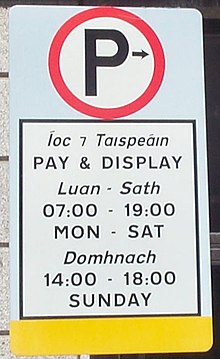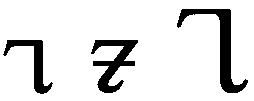Tironian notes
Tiro's position required him to quickly and accurately transcribe dictations from Cicero, such as speeches, professional and personal correspondence, and business transactions, sometimes while walking through the forum or during fast-paced and contentious government and legal proceedings.[1] Nicknamed "the father of stenography" by historians,[4] Tiro developed a highly refined and accurate method that used Latin letters and abstract symbols to represent prepositions, truncated words, contractions, syllables, and inflections.[7] According to Plutarch in "Life of Cato the Younger", Cicero's secretaries established the first examples of the art of Latin shorthand:[8] This only of all Cato’s speeches, it is said, was preserved; for Cicero, the consul, had disposed, in various parts of the senate-house, several of the most expert and rapid writers, whom he had taught to make figures comprising numerous words in a few short strokes; as up to that time they had not used those we call short-hand writers, who then, as it is said, established the first example of the art.There are no surviving copies of Tiro's original manual and code, so knowledge of it is based on biographical records and copies of Tironian tables from the medieval period.[1] Historians typically date the invention of Tiro's system as 63 BC, when it was first used in official government business according to Plutarch in his biography of Cato the Younger in The Lives of the Noble Grecians and Romans.[9] Before Tiro's system was institutionalized, he used it himself as he was developing and fine-tuning it, which historians suspect may have been as early as 75 BC, when Cicero held public office in Sicily and needed his notes and correspondences to be written in code to protect sensitive information he gathered about corruption among other government officials there.[10] In the 15th century Johannes Trithemius, abbot of the Benedictine abbey of Sponheim in Germany, discovered the notae Benenses: a psalm and a Ciceronian lexicon written in Tironian shorthand.This additional function of a phonetic as well as a conjunction placeholder has escaped formal Modern English; for example, one may not spell the word sand as s& (although this occurs in an informal style practised on certain Internet forums and sometimes in texting and other forms of instant messaging).



Marcus Tullius TiroUnicodeUnicode rangeU+204AU+2E52phonetic transcriptionsInternational Phonetic AlphabetshorthandMarcus Tullius Ciceromedieval periodligaturespraenominainscriptionsLatin lettersprepositionscontractionsinflectionsAtticusabstract symbolsDio CassiusMaecenasIsidore of SevilleQuintus EnniusPlutarchCato the YoungerSicilyfirst Catilinarian conspiracySenecaCarolingian dynastyThomas Becketarchbishop of CanterburyJohannes TrithemiusSponheimOld EnglishModern Englishpay and displayScottish GaelicR rotundablackletteret ceteraMicrosoft WindowsSegoe UI SymbolChromeOSDejaVu SansWindows 11Dictionary of the Irish Languagebox-drawing characterPrivate Use AreaMedieval Unicode Font Initiative (MUFI)Letter of Consolation for Departing WarriorsAmpersandGaelic scriptScribal abbreviationEtymologiaeDryden, JohnClough, Arthur HughÉmile ChatelainMonumenta Germaniae Historicawriting systemsHistory of writingGraphemeundecipheredinventorsconstructedby first written accountsAbjadsNumeralsAramaicHatranArabicElifbaEgyptian hieroglyphsElymaicHebrewAshuriCursiveSolitreoTifinaghMandaicManichaeanNabataeanAncient North ArabianPahlaviInscriptionalInscriptional ParthianPsalterPhoenicianPaleo-HebrewPitman shorthandProto-SinaiticSamaritanSouth ArabianSogdianSyriacTeeline ShorthandUgariticAbugidasBrahmicBengali–AssameseBhaiksukiBrahmi scriptDevanagariGujaratiGurmukhiKaithiKalingaKhojkiKhudabadiLaṇḍāLepchaMahajaniMarchenMeiteiMultaniNagariNandinagariNepalese scriptsBhujimolPracalitRanjanaTamyigTirhutaLitumolKaraniʼPhags-paSharada
